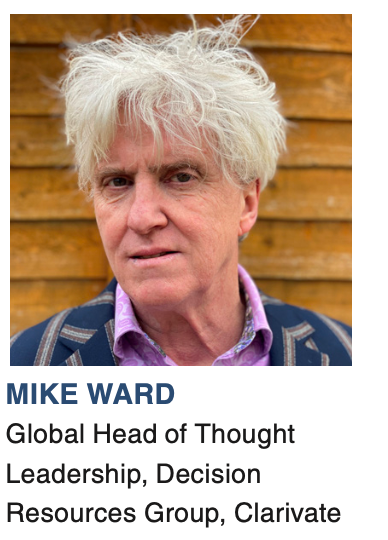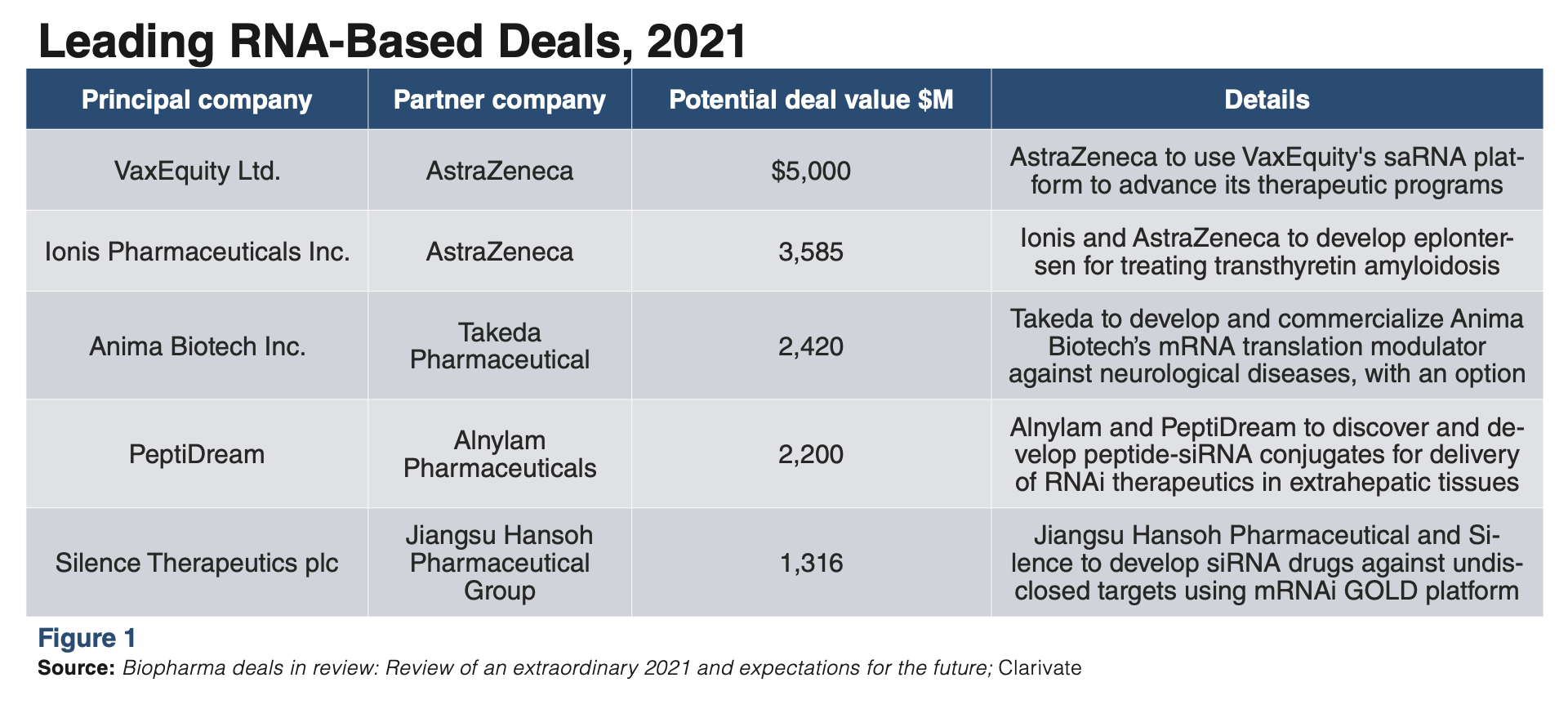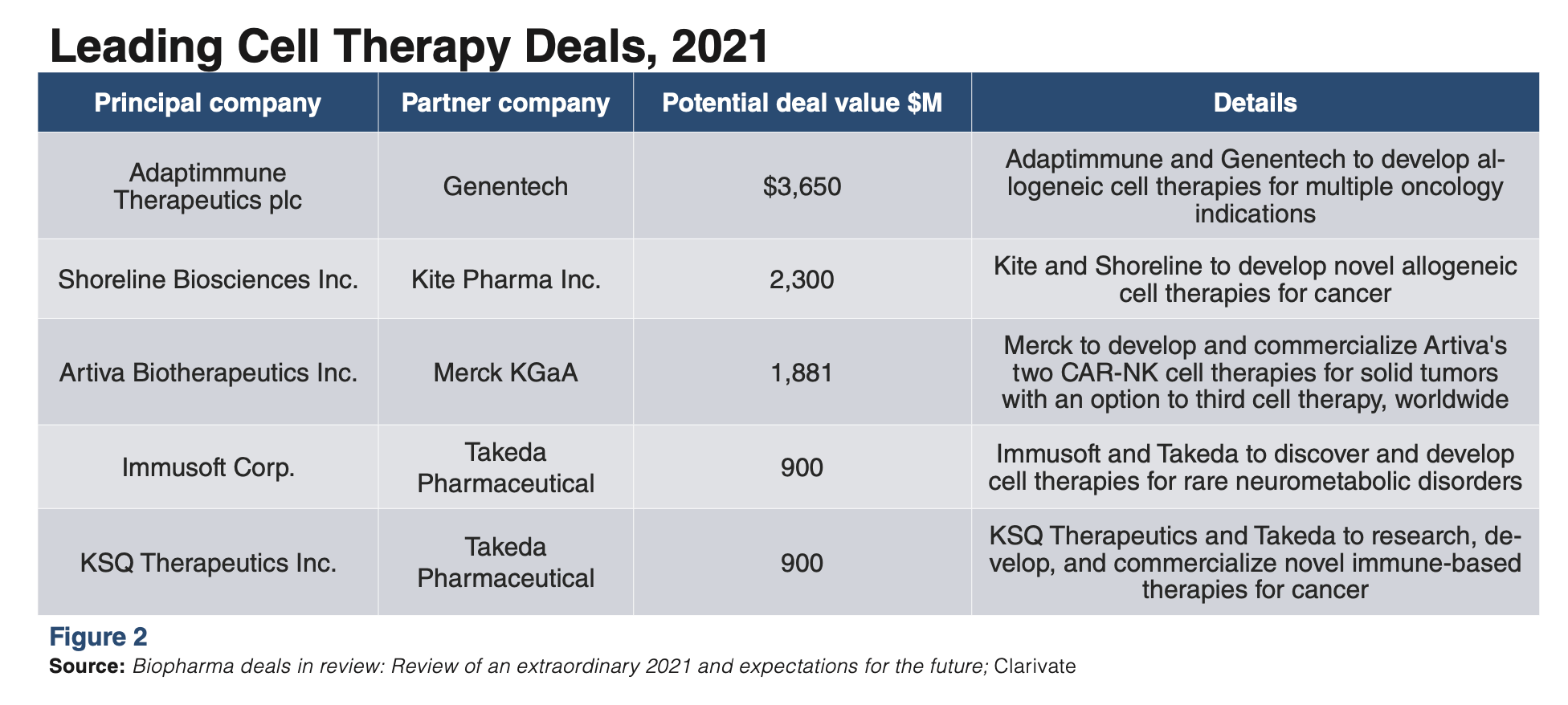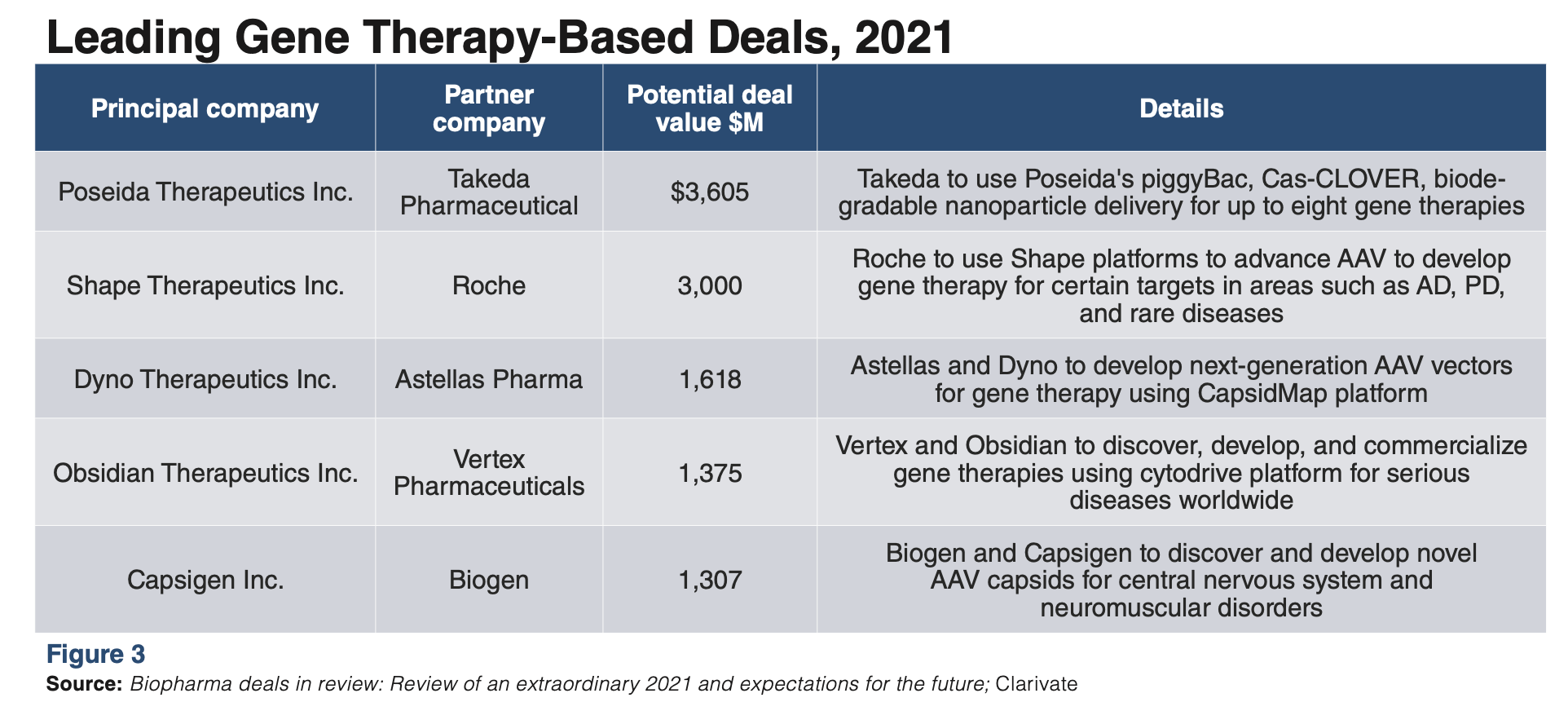Next-Gen Partnerships: The Ascent of Advanced Therapies
With added push from the COVID-19 pandemic, investment in promising RNA- and cell and gene therapy-based treatments and technology via industry dealmaking is growing considerably.

Biopartnering activity between large pharmaceutical and biotechnology companies in 2021 hit record levels. A record 1,968 deals were announced last year, and the total value of these ventures for which financial details were disclosed was $213.6 billion, up from $198.2 billion in 2020.1 While deals involving oncology assets continue to take the largest share of the pharma dealmaking investment pie, the desire to access technology platforms that are anticipated to drive the development of the next generation of blockbuster drugs underpinned some large deals in the RNA technology and cell and gene therapy fields.
Running with RNA
Successful development of mRNA vaccines during the COVID-19 pandemic and the approval of RNAi-based medicines in recent years have catalyzed the desire at life sciences companies to get access to and develop RNA-based platforms through partnerships and acquisitions.
British multinational pharma AstraZeneca established two potentially lucrative partnerships (see Figure 1 below). In the largest preclinical deal of 2021, potentially worth in excess of $5 billion, AZ reached an agreement to collaborate with Imperial College spinout VaxEquity for the discovery, development, and commercialization of a self-amplifying RNA (saRNA) therapeutics platform developed at the university.2 AZ also entered into a new global development and commercialization agreement with Ionis Pharmaceuticals for eplontersen, a liver-targeted antisense therapy in Phase III development for the treatment of transthyretin amyloidosis, a systemic, progressive, and fatal condition.3

Under the terms of the saRNA deal, AZ will support VaxEquity with research and development funding. Should the pharma giant advance any of the research programs into its pipeline, VaxEquity also could receive development, approval, and sales-based milestones totalling up to $195 million and royalties in the mid-single digits per program. AZ has the option to collaborate with VaxEquity on up to 26 as yet undisclosed drug targets and will make an investment in the company to further the development of the saRNA platform.
In its deal with Ionis, AZ will provide the company an upfront payment of $200 million and additional conditional payments of up to $485 million following regulatory approvals. It also will pay up to $2.9 billion of sales-related milestones based on sales thresholds between $500 million and $6 billion, plus royalties in the range of low double-digit to mid-20s percentage, depending on the region.
AZ and Ionis will jointly develop and commercialize eplontersen in the US, while the British pharma will develop and commercialize it in the rest of the world, except in Latin America.
Hereditary amyloid transthyretin polyneuropathy (ATTR-PN) is expected to be the first indication for which the companies will seek regulatory approval for eplontersen, with the potential to file a new drug application with FDA by the end of 2022.
Often partnerships can pave the way to outright acquisition of the innovating partner. Indeed, two of the largest pharma M&A transactions last year—2021 was a relatively quiet year for pharma M&A—were focused on RNA companies. Novo Nordisk acquired RNAi-based drug developer Dicerna Pharmaceuticals for $3.3 billion,4 while Sanofi scooped up mRNA vaccine developer Translate Bio for $3.2 billion.5
Novo Nordisk and Dicerna had been working together since 2019,6 when the companies started to collaborate on the discovery and development of novel treatments of liver-related cardio-metabolic diseases, including chronic liver disease, nonalcoholic steatohepatitis (NASH), type 2 diabetes, obesity, and rare diseases,like endocrine disorders and bleeding disorders, using Dicerna’s proprietary GalXC™ RNAi platform technology. By acquiring Dicerna, Denmark-based Novo Nordisk expects to expand its usage of RNAi technology.
Building on Sanofi’s establishment of its $400 million mRNA Center of Excellence,7 the French pharma multinational acquired Translate Bio to unlock the potential of mRNA in other strategic areas such as immunology, oncology, and rare diseases, in addition to vaccines. Sanofi and Translate Bio had been collaborating since June 2018,8 initially to develop mRNA vaccines, but further expanded in 2020 to broadly address current and future infectious diseases.9 On the therapeutic side, Translate Bio was developing an early stage pipeline in cystic fibrosis and other rare pulmonary diseases, with discovery work in diseases that affect the liver.
Translate Bio’s MRT™ platform may also be applied to various classes of treatments, such as therapeutic antibodies or vaccines in areas such as oncology.
Earlier in 2021, Sanofi had acquired Tidal Therapeutics, a privately owned, preclinical-stage biotech company with a novel mRNA-based approach for in vivo reprogramming of immune cells. It had an upfront payment of $160 million and up to $310 million upon achievement of certain milestones, to expand its mRNA research capabilities in both immuno-oncology and inflammatory diseases.10
Teaming on cell and gene therapies
Cell and gene therapy platforms were also an attractive target for large pharma dealmakers, with Roche and Takeda being among the most active (see Figures 2 and 3 below). Indeed, nearly 15% of the deal value in 2021, about $31.2 billion, was earmarked for cell and gene therapy efforts.11 These therapies are addressing typically underserved patient populations, such as those with rare diseases—for example, spinal muscular atrophy and inherited retinal dystrophies such as retinitis pigmentosa and Leber’s congenital amaurosis—and certain oncology indications.


In the cell therapy field, Roche group company Genentech entered into a strategic collaboration and license agreement with British cell therapy developer Adaptimmune to develop and commercialize allogeneic cell therapies to treat multiple oncology indications.12 Meanwhile, in the gene therapy space, the Swiss parent entered into a multitarget strategic alliance and license agreement with Shape Therapeutics to advance the US biotech’s adeno-associated viruses (AAVs)-based RNA editing technology to discover potentially transformative treatment options for people living with Alzheimer’s disease, Parkinson’s disease, and rare diseases.13
Under the terms of the Adaptimmune deal, which will focus on the development of allogeneic T-cell therapies for up to five shared cancer targets as well as the development of personalized allogeneic T-cell therapies, using the UK biotech’s induced pluripotent stem cell (iPSC)-derived allogeneic platform to produce T-cells, Genentech paid $150 million upfront and could pay an additional $150 million over five years. Adaptimmune may be eligible to receive research, development, regulatory, and commercial milestones payments potentially exceeding $3 billion in aggregate value, as well as receiving tiered royalties on net sales in the mid-single to low-double digits.
In the gene therapy deal with Roche, ShapeTherapeutics will conduct preclinical research to identify and deliver development candidates discovered by its AI-powered platforms RNAfix™ and, potentially, AAVid.™ Shape Therapeutics is eligible to receive an initial payment as well as development, regulatory, and sales milestones payments, potentially exceeding $3 billion in aggregate value. Roche will be responsible for the development and worldwide commercialization of any potential products resulting from the collaboration, while Shape Therapeutics will be eligible to receive tiered royalties on future sales of products resulting from the collaboration.
Potentially the largest gene therapy partnership signed in 2021 was a research collaboration and exclusive license agreement inked by Japanese Takeda Pharmaceutical and Poseida Therapeutics.14 The partnership underpins Takeda’s commitment to investing in next-generation gene therapy approaches that it believes have the potential to deliver functional cures to patients with rare genetic and hematologic diseases.
Under the terms of the deal, which will involve Takeda utilizing Poseida’s piggyBac, Cas-CLOVER, biodegradable DNA and RNA nanoparticle delivery technology, and other proprietary genetic engineering platforms for up to eight gene therapies, Poseida received $45 million upfront and is eligible for preclinical milestones that could exceed $125 million, if milestones for six programs are achieved.
Poseida is also eligible to receive future milestones of up to $2.7 billion if milestones for all six programs are achieved, or up to $3.6 billion if the milestones related to two optional programs are also achieved.
Takeda also had a busy 2021 building up its cell therapy expertise. It signed partnerships, both valued at up to $900 million, with Immusoft, to discover and develop cell therapies for rare neurometabolic disorders,15 and KSQ Therapeutics, to research, develop, and commercialize novel immune-based therapies for cancer.16
The Immusoft collaboration will utilize the US cell therapy company’s Immune System Programming technology platform, which modifies a patient’s B cells and instructs the cells to deliver gene-encoded therapies, and will focus on delivering protein therapeutics across the blood-brain barrier. KSQ granted Takeda an exclusive, worldwide, royalty-bearing license to develop, manufacture, and commercialize cell and non-cell therapy products that modulate targets identified using its CRISPRomics technology, focusing on two T-cell targets previously identified and validated by KSQ, with the potential to introduce two additional T-cell targets to the collaboration.
Also, in a bid to expand its immuno-oncology and innate immune cell therapy portfolio with novel platforms, Takeda hit the acquisition trail by exercising its right to acquire GammaDelta Therapeutics for an undisclosed pre-negotiated upfront and future potential milestones.17
Through the acquisition, which follows a multiyear collaboration between the two companies first established in 2017,18 Takeda will obtain GammaDelta’s allogeneic variable delta 1 gamma-delta T-cell therapy platforms, which include both blood-derived and tissue-derived platforms, in addition to early stage cell-therapy programs.
More in store
In the past decade, there has been an explosion in RNA technology and cell and gene therapy research. The number of academic articles on mRNA published per year rose from 17,191 in 2011 to 23,394 in 2020, while there are currently 46 Phase II and Phase III trials, involving 2,575 patients, being conducted with RNA-based drug candidates.19 Similarly, the number of academic articles reporting cell and gene therapies has risen from 2,933 per year in 2011 to 4,753 in 2020, while there are almost 400,000 patients enrolled in 4,539 active trials.20
With the recent downturn in biotech valuations—in the six months to the end of February, the NASDAQ Biotech Index dropped almost 31.5%, from a high of 5,517.77 in September 2021 to a low of 3776.01 at the end of February—it is anticipated that companies will be keen to establish fundraising biopartnerships with large pharma companies that not only have an appetite for securing transformative technology platforms but have the financial power to license and acquire them. Indeed, the top 10 pharma companies, which posted total 2021 pharma and vaccines revenues of $399 billion and collectively invested $101 billion in R&D, have access to some $220 billion in cash and marketable securities and are forecast to generate some $534 billion free cash flow between 2022 and 2024.
Mike Ward, Global Head of Thought Leadership, Decision Resources Group, Clarivate
References
- https://www.bioworld.com/articles/515071-deals-reach-a-record-2135b-as-m-and-as-in-2021-struggle
- https://www.astrazeneca.com/media-centre/press-releases/2021/astrazeneca-to-discover-and-develop-self-amplifying-rna-therapeutics-in-new-collaboration-with-vaxequity.html
- https://www.astrazeneca.com/media-centre/press-releases/2021/astrazeneca-ionis-to-collaborate-on-eplontersen.html
- https://investors.dicerna.com/news-releases/news-release-details/novo-nordisk-announces-completion-dicerna-pharmaceuticals
- https://www.sanofi.com/en/media-room/press-releases/2021/2021-09-14-15-26-25-2296830
- https://investors.dicerna.com/news-releases/news-release-details/dicerna-and-novo-nordisk-enter-agreement-discover-and-develop
- https://www.sanofi.com/en/media-room/press-releases/2021/2021-06-29-10-00-40-2254458
- https://www.sanofi.com/en/media-room/articles/2018/inoculation-innovation
- https://www.sanofi.com/en/media-room/press-releases/2020/2020-06-23-06-59-00
- https://www.sanofi.com/en/media-room/press-releases/2021/2021-04-09-19-45-00-2207664
- https://www.bioworld.com/articles/515071-deals-reach-a-record-2135b-as-m-and-as-in-2021-struggle
- https://www.globenewswire.com/news-
release/2021/09/07/2292303/35803/en/Adaptimmune-Enters-into-a-Strategic-Collaboration-with-Genentech-to-Research-Develop-and-Commercialize-Cancer-targeted-Allogeneic-T-cell-Therapies.html - https://www.globenewswire.com/news-release/2021/08/24/2285515/0/en/Shape-Therapeutics-enters-into-a-strategic-research-collaboration-with-Roche-to-advance-breakthrough-AAV-based-RNA-editing-technology-for-neuroscience-and-rare-disease-indications.html
- https://investors.poseida.com/news-releases/news-release-details/poseida-therapeutics-announces-research-collaboration-takeda
- https://www.immusoft.com/2021/10/13/immusoft-and-takeda-collaborate-to-discover-and-develop-cell-therapies-for-rare-neurometabolic-disorders
- https://ksqtx.com/news-events/ksq-therapeutics-and-takeda-enter-broad-strategic-collaboration-to-research-develop-and-commercialize-novel-immuno-oncology-therapies
- https://www.takeda.com/newsroom/newsreleases/2021/takeda-to-acquire-gammadelta-therapeutics-to-accelerate-development-of-allogeneic--cell-therapies-addressing-solid-tumors
- https://www.takeda.com/newsroom/newsreleases/2017/takeda-and-gammadelta-therapeutics-announce-collaboration--to-advance-tissue-derived-gamma-delta--t-cells
- Drugs to Watch 2022
- Drugs to Watch 2022

FDA Grants Priority Review to Regeneron’s Eylea for Macular Edema Following Retinal Vein Occlusion
April 18th 2025Regulatory action was based on data from the Phase III QUASAR trial, which demonstrated that Eylea HD dosed every eight weeks achieved non-inferior visual acuity outcomes compared to Eylea in patients with macular edema following retinal vein occlusion.
Addressing Disparities in Psoriasis Trials: Takeda's Strategies for Inclusivity in Clinical Research
April 14th 2025LaShell Robinson, Head of Global Feasibility and Trial Equity at Takeda, speaks about the company's strategies to engage patients in underrepresented populations in its phase III psoriasis trials.
New Insights Into T Cell Exhaustion and Inflammation in Long COVID
April 17th 2025Nigel McCracken, chief operating officer, Virax Biolabs, discusses new findings that reveal altered cytokine activity and evidence of T cell exhaustion in long COVID patients, providing deeper insight into post-infection immune disruption.
Key Findings of the NIAGARA and HIMALAYA Trials
November 8th 2024In this episode of the Pharmaceutical Executive podcast, Shubh Goel, head of immuno-oncology, gastrointestinal tumors, US oncology business unit, AstraZeneca, discusses the findings of the NIAGARA trial in bladder cancer and the significance of the five-year overall survival data from the HIMALAYA trial, particularly the long-term efficacy of the STRIDE regimen for unresectable liver cancer.
Amgen’s Imdelltra Demonstrates Significant Overall Survival Improvement in Small Cell Lung Cancer
April 16th 2025In the Phase III DeLLphi-304 trial, patients with small cell lung cancer administered Imdelltra achieved a statistically significant and clinically meaningful improvement in overall survival compared to standard-of-care chemotherapy.